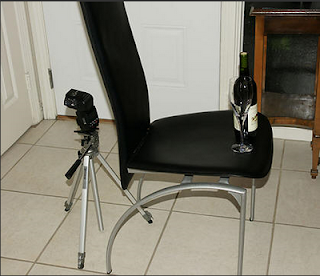How did I take this shot of a wine bottle and glass (below) using no fancy equipment other than a single off-camera wireless flash? Read more to find out!
The image above is the same scene but shot using an onboard flash - what a difference good light makes!
The answer will seem completely unintuitive to you, but it will all make sense after I explain why this works. Below you'll find the identical shots to the two shots above; the only difference is I zoomed out to reveal the setup:
The left picture used an on-board flash; the right picture used the off-camera wireless flash). I had placed the subjects of the picture on a black chair, and placed the chair close to a white wall. Between the chair and the white wall I placed a single off-camera flash, aimed to illuminate the wall as in the picture below:
You can see just how low-tech this setup is. Yet, you can also see the difference in the image when the light originates from behind the chair. All you have to do is crop the picture carefully (as shown in the yellow rectangle below) and you're good to go!
Why does this work? It has to do with the way light reflects off of shiny objects. Normally glass is clear and shapeless when you try to take a picture of it, and so it is necessary to light it in such a way that the light reflects back into the camera, and at the same time defines the shape of the otherwise clear object. Have a look at the illustration below. In this instance, the light bouncing off the white wall will be just scraping by the left and right edges of the chair back, and hit the edge of the glass at just the right angle so it will refract back into the camera (at the bottom of the image). Had I used a wider-backed chair, the lighting effect wouldn't have been nearly so pronounced.
They say that product and food photography are among the most difficult to do properly, because you really have to be aware of your subject, how it reflects light, and how the highlights will help define your subject. Hopefully this simple example will give you a feel for the thinking process involved and an appreciation of just what goes into those perfect-looking catalog photos you would otherwise take for granted.
==================================================
Florida and Nova Scotia seminars are open for enrollment! http://www.FriedmanArchives.com/seminars









great tips!
ReplyDeleteYour explanations are truly enlighening. Thanks.
ReplyDelete